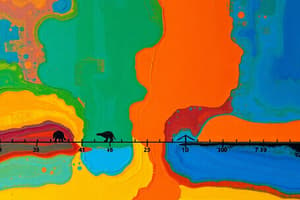Podcast
Questions and Answers
What is the main purpose of Uranium-lead (U-Pb) dating?
What is the main purpose of Uranium-lead (U-Pb) dating?
- Measuring the ratio between rubidium-87 and strontium-87.
- Assessing the ratio between two lead isotopes produced through the decay of uranium isotopes. (correct)
- Estimating the age of objects based on carbon isotopes.
- Calculating the age of volcanic rock.
What does Rubidium-strontium (Rb-Sr) dating measure?
What does Rubidium-strontium (Rb-Sr) dating measure?
- The decay of potassium-40.
- The abundance of argon-40.
- The ratio of carbon-14 in a sample.
- The ratio between rubidium-87 and strontium-87. (correct)
Which radioactive dating method calculates the age of volcanic rock?
Which radioactive dating method calculates the age of volcanic rock?
- Uranium-lead (U-Pb) dating
- Carbon-14 dating
- Potassium-argon (K-Ar) dating (correct)
- Rubidium-strontium (Rb-Sr) dating
What is the primary isotope used in Carbon-14 dating?
What is the primary isotope used in Carbon-14 dating?
How do radiometric dating methods estimate the age of objects?
How do radiometric dating methods estimate the age of objects?
What does a radioactive isotope's half-life represent?
What does a radioactive isotope's half-life represent?
How do scientists calculate the age of a material using radiometric dating?
How do scientists calculate the age of a material using radiometric dating?
What is the significance of measuring carbon-14 (
(${}^{14}$C) and nitrogen-14 (
(${}^{14}$N) in radiometric dating?
What is the significance of measuring carbon-14 ( (${}^{14}$C) and nitrogen-14 ( (${}^{14}$N) in radiometric dating?
Why are accurate estimates from radiometric dating crucial in various scientific fields?
Why are accurate estimates from radiometric dating crucial in various scientific fields?
What allows researchers to construct reliable timelines of Earth's history?
What allows researchers to construct reliable timelines of Earth's history?
Flashcards are hidden until you start studying
Study Notes
Radioactive Dating of Geological Samples
Radioactive dating is a powerful tool used by scientists to determine the age of various materials, primarily from Earth's geologic past. This technique relies on the natural decay rates of radioactive isotopes found within rocks, fossils, and other organic matter. Three main types of radioactive dating methods will be discussed here: those focused on dating geological samples, including carbon dating and more general radiometric dating techniques.
Carbon Dating
One of the most well-known forms of radioactive dating is carbon-14 (C-14) dating, which can estimate the age of once living organisms up to around 60,000 years old. Carbon exists in three naturally occurring isotopes: carbon-12 (stable), carbon-13 (stable), and carbon-14 (unstable). C-14 decays into nitrogen at a known rate, making it suitable for determining when something died based on how much of its original C-14 remains intact. Living organisms continuously take in and store C-14 in proportional amounts with the stable carbon isotopes. Once they die, however, this intake stops, allowing their remaining C-14 levels to decrease over time via radioactive decay while the stable carbon isotope ratios remain constant. By comparing these ratios in modern and ancient samples, researchers infer the elapsed time since death occurred.
Radiometric Dating Methods
Beyond C-14 dating, other radiometric dating methods exist that utilize a broad range of radioactive isotopes present in different geological materials. These techniques allow us to probe deeper into the history of our planet. Various elements commonly employed for such purposes include uranium, potassium, rubidium, thorium, strontium, and samarium. For example, Uranium–lead (U–Pb) dating assesses the ratio between two lead isotopes produced through the decay of uranium isotopes, providing dates going back billions of years. Similarly, Rubidium–strontium (Rb–Sr) dating measures the ratio between rubidium-87 (Rb-87) and strontium-87 (Sr-87), yielding ages spanning from millions to billions of years. Potassium–argon (K–Ar) dating uses the relative abundance of argon-40 (created during the breakdown of potassium-40) to calculate the age of volcanic rock, again producing ages extending far beyond human civilization.
In summary, radioactive dating provides a valuable means of accurately estimating the age of objects and events throughout Earth's history using the inherent properties of unstable atoms. By tracing the gradual decrease in quantity of one radioisotope against the relatively stable supply of another, we gain a precise estimate of elapsed time.
Studying That Suits You
Use AI to generate personalized quizzes and flashcards to suit your learning preferences.




